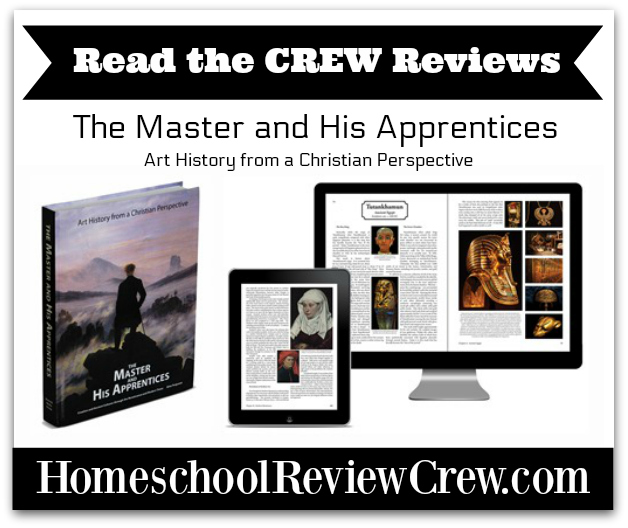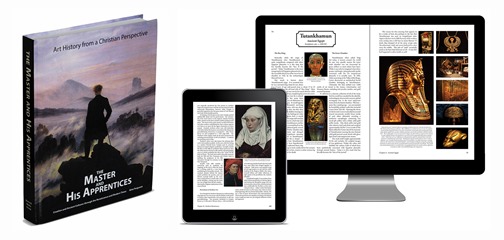Do you do art in your homeschool? How about art appreciation? Or art history? There are so many different things that can fit into the "fine arts" slot in our homeschools and many folks approach it differently. We count things like music lessons, art classes, performance participation or attendance, and more within the realm of "fine arts" in our homeschool program. As a matter of fact, after age 13 fine arts is not a requirement in our state for homeschoolers.
The way the curriculum is designed to be used is that the student reads the text and then completes questions about the segment read. Occasionally there are exams (4 of them) as well as papers assigned (4 as well). Accompanying the student text is a teacher's copy, which is super-handy! It gives a very nice sample syllabus as well as weekly example for use for a year.
 |
| The sample schedule contains readings, assignments, and exams |
There are worksheets that are for the student to use after he or she has read the assigned pages (or chapter). We actually used them along with the reading, as a kind of guided note-taking type exercise (or maybe better stated that it was a way to highlight certain information while reading). The GREAT thing about these is that in the teacher's manual there is an answer key for these! Makes it so much easier for the teacher! :)
 |
The worksheets allow the student and teacher
to make sure highlights/important points are retained. |
There are also exams which are combinations of question types: matching, fill in the blank, list, define, short essays, etc. so they nicely cover a variety of assessment types. Answers to these are also included in the teacher's manual (yay!).
SO what types of things are taught in The Master and His Apprentices: Art History from a Christian Perspective ? Well, a lot of topics. The study begins with an talk about God being the Creator, the originator of all that is good and as such the "Master" of all art, with humans just his "apprentices". The second chapter walks the student through the days of creation. The author espouses the Young Earth Theory of Creationism.
 |
| Chapter 2 is devoted to explaining the days of Creation |

 Chapters following this cover different artistic trends from ancient times up through about the 1700's. That is a broad statement, but it is actually from pages 22 through 306. Different styles of art throughout different historical periods are highlighted and illustrated. Ancient Egypt, Minoans, Etruscans, Ancient Greece, and more!
Chapters following this cover different artistic trends from ancient times up through about the 1700's. That is a broad statement, but it is actually from pages 22 through 306. Different styles of art throughout different historical periods are highlighted and illustrated. Ancient Egypt, Minoans, Etruscans, Ancient Greece, and more!
Architecture, sculpture, paintings, and more are discussed along with cultural significances.
Timelines are also printed, which are very helpful for seeing events/artists/periods in context.
When the time frames get up to about the 1200's, the author begins to teach about particular artists and some of their works, mainly to illustrate art trends of the period.
Oddly enough, when the book arrives at the 1700's, it kind of stalls out. To illustrate my point, when we get to page 306, the chapter covers from the rococo period of the 1700's through today. . .in just 7 pages!!! Uhhhh.. The author does state that this chapter is to be used as a "springboard" to inspire students to do independent learning on some of the later trends and artists, but I found it a bit odd.
 |
After the length of discussion about earlier times, the
discussion of more modern times seems quite brief to me.. |
 My 13 year old daughter was the student who got to try out this curriculum. She said that the first two chapters kind of seemed like a Bible lesson (yes) and not really like art. As she went on in further chapters her remarks were that it felt more like what we had covered in ancient history classes (yes). To get a feel for some of the later chapters she skipped ahead and read a bit about some of the different artists, which she thought felt a lot different than the earlier topics (more detail given to separate artists as examples of trends of their times).
My 13 year old daughter was the student who got to try out this curriculum. She said that the first two chapters kind of seemed like a Bible lesson (yes) and not really like art. As she went on in further chapters her remarks were that it felt more like what we had covered in ancient history classes (yes). To get a feel for some of the later chapters she skipped ahead and read a bit about some of the different artists, which she thought felt a lot different than the earlier topics (more detail given to separate artists as examples of trends of their times).
I think that my suggestion regarding this curriculum would be to use it concurrently with a course in ancient history or history of western civilization. I think it would be more impactful that way, as a supplement to the history studies. Yes, some would be a little redundant, but repetition helps with retention, right?
One thing that sets this curriculum apart is that it intentionally does not include nudity. Now, as we all know, nudity in art is not isolated to one time frame or just a few artists, but this author has chosen to not include nude representations in this book. One part of me thinks this is fine, remembering when my kids were younger and they were a little shocked by some artistic portrayals, but then--does it represent the artists truly? For instance, there is a section on Rubens which--when we hear the name Rubens, what do we usually think about? Large, plump naked women in his art, right? I know that is not all he painted, but I think culturally now that is what we usually associate with him. But this is not addressed, leading me to wonder what other things have been left out in acquiscence with this theme. Well, the author is not trying to mis-lead, it is made clear that it is intentional that nudity is left out, but, I don't know, are we missing something by just leaving this out?
 |
| Wow, a whole section about Rubens without chubby naked females? |
The product that we used for this review was a digital copy of both the student text and the teacher's manual. I am not a huge fan of digital books for textbooks. I'd rather have the physical copy; that being said, I do realize that you can print the electronic copy--we opted not to because it was just way too many pages for me to print :) (or to pay for having printed). SO -- my comment on the digital copy (using it on a computer) is that it is a little difficult to use in the two-column form using Acrobat Reader--because it's two columns, you need to read down the column and then scroll back up to the top of the page to begin the second column. Sounds really picky and shallow when I read what I just wrote, but it was a bit annoying :) I guess that's why I prefer physical copies!
So...for a wrap-up. The Master and His Apprentices is a very Christian-based history of art, mostly from ancient times through the 1600's or so. It is intended for a high school audience, whether homeschool or small class. (***The front material states that it is intended for use by ONE student, if you wish to print the worksheets for further students the cost--at this time, at least--is $2 per student). Added to the Christian distinctives is another distinctive in the world of art books, and that is not including nudity. So if that's what you're after, you may want to look into this product.
To read what other homeschooling families have to say about The Master and His Apprentices: Art History from a Christian Perspective, please click on the banner below!






 Chapters following this cover different artistic trends from ancient times up through about the 1700's. That is a broad statement, but it is actually from pages 22 through 306. Different styles of art throughout different historical periods are highlighted and illustrated. Ancient Egypt, Minoans, Etruscans, Ancient Greece, and more!
Chapters following this cover different artistic trends from ancient times up through about the 1700's. That is a broad statement, but it is actually from pages 22 through 306. Different styles of art throughout different historical periods are highlighted and illustrated. Ancient Egypt, Minoans, Etruscans, Ancient Greece, and more!
 My 13 year old daughter was the student who got to try out this curriculum. She said that the first two chapters kind of seemed like a Bible lesson (yes) and not really like art. As she went on in further chapters her remarks were that it felt more like what we had covered in ancient history classes (yes). To get a feel for some of the later chapters she skipped ahead and read a bit about some of the different artists, which she thought felt a lot different than the earlier topics (more detail given to separate artists as examples of trends of their times).
My 13 year old daughter was the student who got to try out this curriculum. She said that the first two chapters kind of seemed like a Bible lesson (yes) and not really like art. As she went on in further chapters her remarks were that it felt more like what we had covered in ancient history classes (yes). To get a feel for some of the later chapters she skipped ahead and read a bit about some of the different artists, which she thought felt a lot different than the earlier topics (more detail given to separate artists as examples of trends of their times).






No comments:
Post a Comment